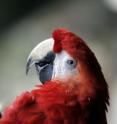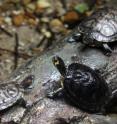75 percent of Spanish zoos at risk of exotic animals escaping
Lions, bears, monkeys, crocodiles, parrots and iguanas may seem inoffensive at first glance when they're behind bars in zoos. But some exotic species can escape and become invasive species. This has been confirmed by a scientific team that has checked 1,568 animal houses in 63 Spanish zoos. Birds are the animals most likely to escape. "As zoos house a large number of exotic (non-indigenous) species, they could become an entry channel for these species if they escape, with the potential environmental risk that this implies", María C. Fàbregas, lead author of the study and a researcher at the Ethology and Animal Welfare Unit of the Cardenal-Herrera University (UCH) in Valencia, tells SINC.
The study, which has been published in the journal Biological Invasions, reviewed the security of animal housing against creatures escaping, and 75% of the zoos studied were found to be problematic, while 14% of the animal housing was evaluated as "insecure" against the possibility of escape.
"Species that could pose a danger to public health are usually housed in secure accommodation, but those that could represent a danger to the environment if they escaped (invasive species) tend to be in insecure housing", points out Fàbregas. According to the research, birds are the group most likely to be in insecure housing.
Based on a report produced in 2003 by the Ministry of the Environment, Rural and Marine Affairs (MARM), the research team studied 30 animal houses in each of the 63 zoos. The MARM is currently completing the first inventory of zoos and aquaria in Spain.
"Of the 1,568 animal houses studied, 221 were insecure against the threat of the species housed in them escaping, 167 housed non-indigenous species (potentially dangerous to the environment), and of these 21 housed invasive species", the scientist explains.
The animals could escape from 71% of the insecure housing by getting through or over the physical barrier around their accommodation. The rest could get out "because the public could release them or remove them from their cages or tanks".
Zoos, sources of invasive species
"Invasive species are one of the leading causes of biodiversity loss, but they can also have negative effects on human health, agriculture and the economy. Controlling their entry routes is the most effective way of tackling this threat", the researcher says.
Although many "potentially" invasive species are "inoffensive to human beings", some – including pets such as the red-eared slider turtle (Trachemys scripta), green iguanas (Iguana iguana), parrots and parakeets – are "dangerous" to the environment if they escape.
The team says that zoos, already recognised as a source of invasive species, should adopt "all the measures available to them to prevent their animals from escaping". "Preventing non-indigenous species from entering the environment is the best way of tackling the problem of biological invasions", says Fàbregas.
The scientists believe that it is "of utmost importance" to alert zoos to the environmental danger of non-indigenous species "in order to prevent them from escaping". Zoos are also an important tool for educating the public.
The researchers also propose putting an emergency plan in place to deal with the accidental escape of animals, not just in the case of species that are dangerous to the public, but also for those that could harm the environment.
Among other measures, the scientists recommend not allowing animals to walk freely within the zoo grounds, and ensuring there is a physical barrier marking the zoo boundaries, and preventing individuals from escaping through drains, sewers or any other channels.
One measure that is already common in some zoos is for them to have their own waste water treatment system, particularly at parks with aquaria or those near the coast. The goal is to prevent pathogens and parasites from getting out, as well as "any other potentially dangerous biological material (seeds, larvae, fragments of aquatic plants, etc.)", says Fàbregas.



